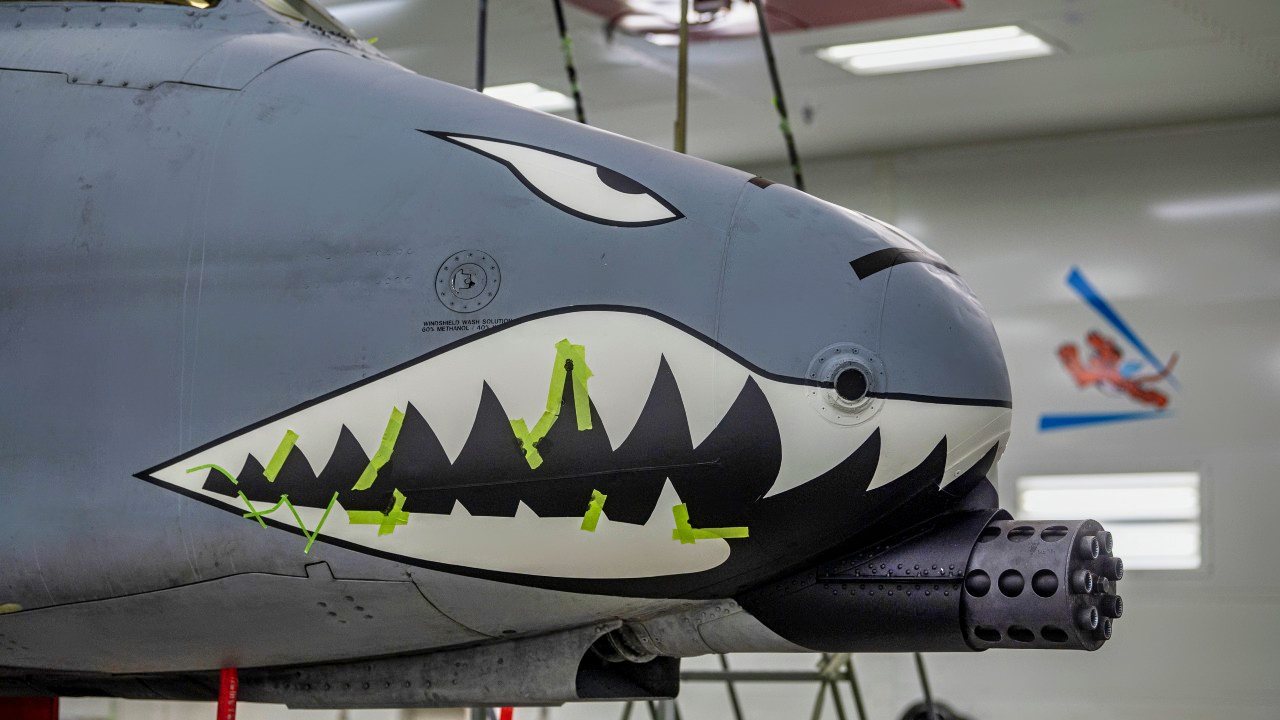How to Make the F-16 Fighter Even Deadlier: Give It an A-10 Warthog Cannon
In the twilight of the Cold War, the U.S. Air Force explored replacing the A-10 Thunderbolt II, known for its 30mm GAU-8 Avenger cannon, with a variant of the F-16, dubbed the A-16 and later the F/A-16.
Summary and Key Points: In the twilight of the Cold War, the U.S. Air Force explored replacing the A-10 Thunderbolt II, known for its 30mm GAU-8 Avenger cannon, with a variant of the F-16, dubbed the A-16 and later the F/A-16.

-This concept involved fitting the nimble F-16 with a pod-based version of the A-10's cannon, aiming to create a more survivable close air support (CAS) platform.
-The A-16 underwent limited combat testing during Operation Desert Storm, but the idea was quickly abandoned after the cannon proved ineffective due to mounting issues and the F-16's high-speed flight profile, which hindered precise targeting.
-Despite efforts to replace the A-10, the Warthog proved irreplaceable in its CAS role, and it remains a legendary combat aircraft, beloved by troops and aviation enthusiasts alike.
The A-16: Why the F-16 Failed to Replace the Legendary A-10 Warthog
The A-10 Thunderbolt II, better known as the Warthog, is renowned for its massive 30mm GAU-8 Avenger rotary cannon. But for a short time in the twilight of the Cold War, the Air Force wanted to know if it could replace the low-and-slow Warthog by strapping a variant of the same massive gun to the light-and-nimble F-16.
This concept, known initially as the A-16 and later as the F/A-16, would see the broadly capable fighter absorb the A-10’s close air support (CAS) role by delivering a variety of air-to-ground munitions. Most prominent among its weapon systems would be gun pods carried beneath each wing and the aircraft’s center pod. These pods would house a pair of matching 7.62mm miniguns underwing, which were meant to support the primary gun system bolted to the F-16’s belly: a 30mm rotary cannon that fired Red Bull-can-sized depleted uranium projectiles at ground targets at 40 rounds per second.

This combination of the F-16’s speed and agility and the A-10’s incredible firepower, the Air Force hoped, would result in a more survivable close air support platform – one that would be capable of offering the Warthog’s ground-pounding presence without its vulnerability to enemy air defenses.
The idea seemed so promising that a small batch of F-16s were even modified and equipped with a new pod-based variant of the A-10’s mighty cannon and deployed to Iraq for Operation Desert Storm, where a group of pilots from the New York Air National Guard were tasked with determining once and for all whether or not this new F/A-16 concept had wings.
However, within just about 48 hours worth of combat operations, the Air Force came to realize that despite their concerns about how survivable the Warthog may be in contested airspace, not even mounting a 30mm cannon on the F-16 would be enough to bring the A-10 down.
The A-10 has always been living on borrowed time
The Warthog’s path to duty arguably began during the Vietnam War, when the United States came to recognize that high-speed, low-loiter time platforms like the F-4 Phantom were ill-suited to fly close air support missions for troops on the ground. As a result, the Air Force turned to its Korean War-era A-1 Skyraider for the job, but with a standard cruising speed of under 200 miles per hour and four 20mm cannons onboard with just 200 rounds per weapon, the aircraft not only lacked the necessary firepower but was also seriously vulnerable to small arms fire.
Yet, while the need for the A-10 may have been first recognized in the Far East, the aircraft’s focus throughout development was decidedly further West – namely, in a lowland corridor on the border between East and West Germany known as the Fulda Gap.
This area, some 60 miles northeast of Frankfurt, included several narrow open passes tucked away between rolling German hills making it uniquely suited to allow columns of Soviet armor to pour into Europe if the Cold War suddenly turned hot. With only around 250,000 American troops pre-positioned in Western Germany at the time, and roughly 1.2 million Soviet and Warsaw Pact troops staring them down from the opposing side of the Fulda Gap, NATO planners had no illusions about their chances at successfully stopping such an assault.
“This is the frontier where it would happen,” Col. Thomas E. White, commander of the 4,500 troops in the 11th U.S. Armored Cavalry stationed at the mouth of the Fulda Gap, told the LA Times in 1987.
The pressing need to find a way to curtail an armored Soviet advance in this region certainly informed the selection of the A-10’s primary weapon system – a massive hydraulically driven seven-barrel rotary cannon capable of slinging 30mm armor-piercing rounds with selectable speeds of 2,100 rounds per minute or a mind-blowing 4,200 rounds per minute. At full tilt, this 20-foot monster of a weapon could deposit 70 rounds on target per second, meaning the Warthog could empty its entire standard loadout in just over 16 seconds of sustained fire.
While that might not seem like much, there aren’t many targets on the planet that could withstand a full second of sustained fire from this powerful weapon, making the 1,150-round standard loadout (and 1,174-round maximum loadout) more than enough to have the necessary impact.
With a maximum effective range of 4,000 feet, this weapon came to dictate the A-10’s flight profile. That massive gun, dubbed the GAU-8 Avenger, was mounted along the aircraft’s center line and angled down only slightly, which meant Warthog pilots would need to fly just about directly at their targets on the ground in a shallow 30-degree dive and close to within 4,000 feet to engage them. With what was sure to be a symphony of Soviet air defense weapons firing from below, the A-10 would not be able to avoid being hit, so it was designed specifically to stay flying even after absorbing an immense amount of punishment.
For this reason, the A-10 boasted double-redundant hydraulic flight control systems, as well as a mechanical backup in case both of those systems failed. The cockpit was encased in 1,200 pounds of titanium armor ranging in thickness from 0.5 inches to 1.5 inches – enough to withstand a direct hit from 23mm gunfire and indirect hits from weapons as large as 57mm. Its engines were positioned high atop the aircraft, limiting the chances of debris being sucked into them while operating from austere forward airstrips. Self-sealing fuel tanks with check valve-equipped fuel lines helped ensure any puncture of the fuel system wouldn’t result in the jet going down.
The A-10 was over-engineered to be able to make it home while down an engine, or after losing half the tail or half of one of its wings. The Warthog was meant to be a flying tank, but even with all its baked-in survivability, the Air Force still recognized that the aircraft itself… just wasn’t all that survivable.
According to a report published by Combat Aircraft magazine, the Air Force still predicted that a war in Europe would result in substantial A-10 losses, as the aircraft were tasked with engaging columns of Soviet armor amid an inverted hail storm of anti-aircraft fire. Estimates projected that in every 100 sorties, the branch could expect to lose roughly seven percent of its deployed A-10s, which was a big problem, seeing as the plan to stifle a Soviet advance through the Fulda Gap called for each pilot to fly roughly four sorties per day for a combined minimum of 250.
As War Is Boring would later point out, a seven percent loss rate flying at that operational tempo would have meant that each of the six A-10 forward operating locations in Europe would lose at least 10 airframes per day. At that rate, America would lose every A-10 in its fleet – roughly 700 jets – in under two weeks.
That is to say that the A-10 Thunderbolt II wasn’t designed to survive in contested airspace but was rather built to last just long enough to inflict heavy losses on invading Soviet forces before being all but inevitably shot down. This concept of operations might sound cynical to our modern ears, but it’s important to understand the stakes of such a conflict between nuclear powers. After all, Warthog pilots wouldn’t be the only ones going out in a blaze of glory if NATO and the Warsaw Pact countries started trading nuclear blows.
Yet, while strapping highly-trained pilots into what could arguably be called heavily armed Kamikaze tank killers may have been seen as an operational necessity at the time, it was very clearly not an optimal solution, and the Air Force started looking for ways to retire its new flying tank almost as soon as it entered service.
Cramming the A-10’s 30mm gun into a pod
Several efforts at fielding more survivable close-air-support aircraft soon emerged, including a heavily modified iteration of the A-7 Corsair II that would have boasted the same F100 afterburning turbofan as the F-15 Eagle, but none managed to demonstrate the necessary combination of value versus survivability needed to step in and replace the still-new A-10.


